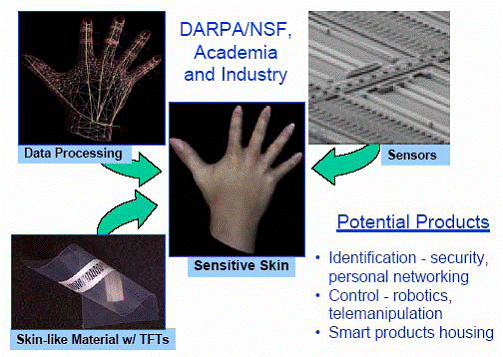Sensitive Skin
Published on Aug 15, 2016
Abstract
Sensitive skin is a large-area, flexible array of sensors with data processing capabilities, which can be used to cover the entire surface of a machine or even a part of a human body. Depending on the skin electronics, it endows its carrier with an ability to sense its surroundings via the skin's proximity, touch, pressure, temperature, chemical/biological, or other sensors.
Sensitive skin devices will make possible the use of unsupervised machines operating in unstructured, unpredictable surroundings among people, among many obstacles, outdoors on a crowded street, undersea, or on faraway planets.
Sensitive skin will make machines "cautious" and thus friendly to their environment. This will allow us to build machine helpers for the disabled and elderly, bring sensing to human prosthetics, and widen the scale of machines' use in service industry. With their ability to produce and process massive data flow, sensitive skin devices will make yet another advance in the information revolution. This paper surveys the state of the art and research issues that need to be resolved in order to make sensitive skin a reality.

Skin Materials
- Sensitive Skin material will hold embedded sensors and related signal processing hardware. It needs to be flexible enough for attaching it to the outer surfaces of machines with moving parts and flexible joints.
- The skin must stretch, shrink, and wrinkle the way human skin does, or to have other compensating features. Otherwise, some machine parts may become "exposed" due to the machine's moving parts, and have no associated sensing.
- Wiring must keep its integrity when Sensitive Skin is stretched or wrinkled. This requirement calls for novel wire materials, e.g. conductive elastomers or vessels carrying conductive liquid, or novel ways of wire design with traditional materials, such as helical, stretchable wires
From the device point one might wish a Sensitive Skin to have some of the following capabilities:
. Flexible or deformable, Can be tiled or cut, This aspect ties in to cost and repair ability, High detectivity, On-skin switching and signal processing, Fault tolerances by distributing functions/computing, or protect processor units. Transmission by wire or optical fiber, or wireless: RF, UHF, free-space optical.
. Power by wire photovoltaics, RF, fuel cells, micro engines, or from energy harvesting - (skin-integrated mechanical power generators). Power storage in batteries. Or as fuel for fuel cells and micro engines.
. Sensitive Skin sensor components will be deployed in two dimensional arrays of sufficiently high density
. Smaller arrays may be of use as well: the key feature is that the skin should allow, by itself or with appropriate data processing, to identify with reasonable accuracy the points of the machine's body where the corresponding sensor readings take place.
. "Self-sensing" ability of the skin is highly desirable; this may include sensing of contamination, dust, chemical substances, temperature, radiation, as well as detection of failure of individual or multiple skin sensors and the ability to work around failed areas.
. The ability to measure distance to objects would be a great advantage for enabling dexterous motion of the machine that carries the skin